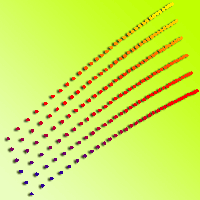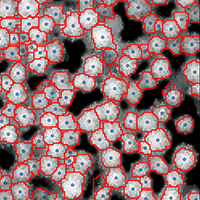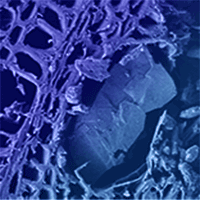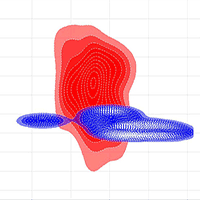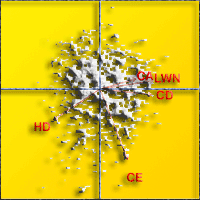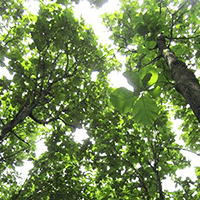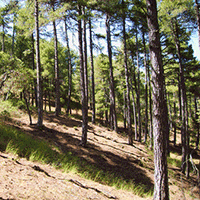
Optimizing the management of uneven-aged Pinus nigra stands between two stable positions
Ignacio López Torres (1) , Sigfredo Ortuño Pérez (1), Fernando García Robredo (1), Carmen Fullana Belda (2)
iForest - Biogeosciences and Forestry, Volume 9, Issue 4, Pages 599-607 (2016)
doi: https://doi.org/10.3832/ifor1298-008
Published: Mar 01, 2016 - Copyright © 2016 SISEF
Research Articles
Abstract
This study proposes a discrete optimal control model to obtain harvest strategies that maximize the net present value (NPV) of the timber harvested from uneven-aged Pinus nigra stands located in the Spanish Iberian System, between two stable positions. The model was constructed using an objective function that integrates financial data on the harvesting operations with a matrix model describing the population dynamics. The initial and final states are given by the stable diameter distribution of the stand, and the planning horizon is 70 years. The scenario analysis corresponding to the optimal solutions revealed that the stand diameter distribution does not deviate substantially from the equilibrium position over time and that the NPV for the optimal harvesting schedule was always greater than the NPV for the “sustainable/stable” harvesting strategy. The NPV increase for the different scenarios is between 5.36% and 14.43%, showing a greater increase in higher site index scenarios and higher recruitments.
Keywords
Sustainability, Stability, Equilibrium, Optimal Harvesting, Discrete Optimal Control, Matrix Model
Authors’ Info
Authors’ address
Sigfredo Ortuño Pérez
Fernando García Robredo
Universidad Politécnica de Madrid (UPM), ETSI de Montes, Ciudad Universitaria, E-28040 Madrid (Spain)
Universidad Pontificia de Comillas, Alberto Aguilera 23, E-28015 Madrid (Spain)
Corresponding author
Paper Info
Citation
López Torres I, Ortuño Pérez S, García Robredo F, Fullana Belda C (2016). Optimizing the management of uneven-aged Pinus nigra stands between two stable positions. iForest 9: 599-607. - doi: 10.3832/ifor1298-008
Academic Editor
Agostino Ferrara
Paper history
Received: Mar 26, 2014
Accepted: Nov 05, 2015
First online: Mar 01, 2016
Publication Date: Aug 09, 2016
Publication Time: 3.90 months
Copyright Information
© SISEF - The Italian Society of Silviculture and Forest Ecology 2016
Open Access
This article is distributed under the terms of the Creative Commons Attribution-Non Commercial 4.0 International (https://creativecommons.org/licenses/by-nc/4.0/), which permits unrestricted use, distribution, and reproduction in any medium, provided you give appropriate credit to the original author(s) and the source, provide a link to the Creative Commons license, and indicate if changes were made.
Web Metrics
Breakdown by View Type
Article Usage
Total Article Views: 47385
(from publication date up to now)
Breakdown by View Type
HTML Page Views: 40158
Abstract Page Views: 2521
PDF Downloads: 3481
Citation/Reference Downloads: 21
XML Downloads: 1204
Web Metrics
Days since publication: 3593
Overall contacts: 47385
Avg. contacts per week: 92.32
Citation Metrics
Article Citations
Article citations are based on data periodically collected from the Clarivate Web of Science web site
(last update: Mar 2025)
Total number of cites (since 2016): 6
Average cites per year: 0.60
Publication Metrics
by Dimensions ©
Articles citing this article
List of the papers citing this article based on CrossRef Cited-by.
References
Matrix population models: construction, analysis, and interpretation (2nd edn). Sinauer Associates Inc., Sunderland, MA, USA, pp. 710.
Gscholar
Modelo de crecimiento y producción para Pinus nigra Arn. en el Sistema Ibérico. [Growth and yield model for Pinus nigra Arn. in the Iberian System]. Montes Revista de Ámbito Forestal 54: 5-18.[in Spanish]
Gscholar
Los pinares de Pinus nigra Arn. en España: ecología, uso y gestión. [The forests of Pinus nigra Arn. in Spain: ecology, use and management]. Fundación Conde del Valle de Salazar - FUCOVASA, Madrid, Spain, pp. 699. [in Spanish]
Gscholar
Introduction to the mathematics of population. Addison-Wesley, Reading, MA, USA, pp. 450.
Gscholar
Boletín mensual de estadística 1994-2011. [Monthly statistical bulletin 1994-2011]. Technical General Secretary of the Spanish Ministry of Agriculture, Food and Environment, Madrid, Spain, pp. 48. [in Spanish]
Gscholar
Determinación del turno de Pinus sylvestris L. en el Sistema Central. [Determination of rotation age for Pinus sylvestris L. in the Central System]. Revista Montes 29: 42-47. [in Spanish]
Gscholar
Le regime du jardinage [The gardening regime]. Chaire de sylviculture, ETH Zürich, Switzerland, pp. 110. [in French]
Gscholar
El problema de la regeneración natural de Pinus nigra Arn. [The problem of natural regeneration of Pinus nigra Arn.]. Revista Montes 36: 52-57. [in Spanish]
Gscholar
Optimal control theory: applications to management science and economics (2nd edn). Kluwer Academic Publishers, Boston, MA, USA, pp. 505.
Gscholar
Forest owners’ guide to the federal income tax. Agriculture Handbook No. 708, USDA Forest Service, Washington, DC, USA, pp. 138.
Gscholar
Dinámica de regeneración de Pinus nigra subs. Salzmannii al sur de su área de distribución: etapas, procesos y factores implicados. [Regeneration dynamics of Pinus nigra subs. Salzmannii south of its distribution area: stages, processes and related factors]. Investigación Agraria: Sistemas y Recursos Forestales 16(2): 124-135.
CrossRef | Gscholar
La alteración del suelo y la espesura como factores de regeneración de Pinus nigra subs. Salzmannii a lo largo de su área de distribución. [Soil alterations and stem density as regeneration factors for Pinus nigra subs. Salzmannii along its distribution area]. Revista Montes 103: 10-15. [in Spanish]
Gscholar
A quantitative study of organic growth (Inquiries on growth laws, II). Human Biology 10: 181-213.
Gscholar

